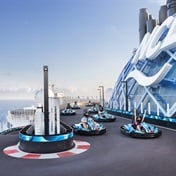Because if the consortium ? under the leadership of Stellenbosch financial services group PSG ? achieves real success with its current offer of 50c/share to Keeromstraat shareholders and/or R127/Naspers A share, the control of Naspers Beleggings won't be as firm as it's often believed.
Keeromstraat, along with Naspers Beleggings, forms Naspers's control consortium with a joint voting interest of 55,7%.
Naspers Beleggings' voting interest in Naspers has diluted from 45% in 1995 to the current 34,1%, largely because Naspers's number of issued N shares increased from 111,4m to 314,5m in the 10 years. The weight of N shares ? which each carry one vote ? in Naspers's voting power therefore increased from 15% to 31% in the 10 years.
If PSG succeeds in gaining control of Keeromstraat's board, it would have a 21,6% voting interest. Considering that Sanlam has a 13,9% voting interest and that Naspers Beleggings can't necessarily rely on Sanlam's support as in the past, and also that the voting power of minorities who invested in N shares is now larger, it's clear why victory in the Battle of Keeromstraat is so important for Naspers's current board.
Keeromstraat doesn't have a controlling shareholder. Nevertheless, Naspers's board controls the company. How is that possible?
Paragraph 50 of the Keeromstraat articles of association states, among other things, that in a vote with ballot papers every member has one vote for the share that he holds, then one vote for the next 1 999 shares, then one vote for every complete 2 000 shares above the first 2 000 to 96 000 shares and then one vote.
That means every shareholder has at most 50 votes, regardless of how many shares he owns. Keeromstraat has about 3 300 shareholders holding 55,4m issued shares ? but due to the voting system there are only 14 550 votes. If PSG acquires control of around 7 300 votes ? in whatever way ? it could take over the Keeromstraat board.
But it's not quite so simple, as clause 13 of the articles of association says, among other things, that the board has the fullest and absolute right to refuse at its own discretion that any transfer of shares should take place or be registered, and that it can do so without any obligation to give the reason for the refusal or to make it known.
Potentially, that clause is a moot point between the Naspers and PSG camps as it restricts the free trading of shares ? which could make it very difficult for PSG to take transfer of any shares.
The tale of Naspers's control structure goes back a long way. Before its listing in 1994, Naspers had similar voting and transfer arrangements to those of Keeromstraat.
In practice, management and the board were therefore in control. In any similar situation where there's such a widely distributed shareholding a board often controls the proxy votes of shareholders who can't attend general meetings.
With the Naspers listing, shareholders acquired only 50% of their shareholding directly in Naspers. An unlisted public company called Nasionale Pers Beherend indirectly acquired a controlling interest of 50% in Naspers through a wholly owned subsidiary, Naspers Beleggings. Naspers's shareholders therefore held the other 50% of their interest in Naspers indirectly through Nasionale Pers Beherend and Naspers Beleggings. Nasionale Beherend's voting and transfer rules were similar to those of Keeromstraat's now.
Complaints by shareholders concerning the lack of liquidity in Naspers Beherend shares led to the formation of the current control structure in 1995. The assistance of corporate adviser Murray Louw was called in. Louw is the brother of Free Market Foundation executive director Leon Louw. One of the sponsoring brokers at the time was Senekal, Mouton & Kitshoff (SMK).
The current chairman of PSG, Jannie Mouton, was, ironically, an SMK director at the time.
The problem was to entrench ? without money ? control over a public company, which at that stage already had a market capitalisation of around R2,5bn. As part of the scheme, Nasionale Pers Beherend unbundled its indirect shareholding in Naspers to its shareholders and in that way overcame the objections concerning the lack of liquidity.
However, it was the question of control that tested the creative talents of executive chairman Ton Vosloo and his advisers to the utmost. The end result 10 years later is shown in the diagram.
It's general knowledge that the A shares, which are held largely by Naspers Beleggings, Keeromstraat and Sanlam, each carry 1 000 votes and the N shares only one vote each. The A shares are unlisted and are entitled to only 20% of the dividends of N shares.
One of the features of the scheme was the acquisition of a 49% interest in Naspers Beleggings by Heemstede Beleggings, a wholly owned subsidiary of Naspers. The buying price was just R5 352 and financed by a loan from Naspers Beleggings. The figure of 49% wasn't random, as if it had been 50% Naspers Beleggings would have been a Naspers subsidiary while it was the main cog in that company's control structure.
Naspers Beleggings was initially to obtain 557 000 A shares in Naspers. However, that would have amounted to a voting interest of 67% ? which would have meant that Naspers would, in turn, have been a subsidiary of Naspers Beleggings.
Though a Naspers newsletter of 19 October 1995 didn't mention anything about the existence of Keeromstraat, it did report that Naspers Beleggings would see to it that it didn't control more than 45% of the Naspers vote. The rest would be placed with third parties.
The only third party was Keeromstraat, which now owns 219 344 A shares in Naspers, while Naspers Beleggings owns 350 000 A shares. That's after Naspers Beleggings sold 33 059 A shares to Keeromstraat two years ago. Whether the transaction took place in terms of a pre-emptive agreement isn't clear, as nothing is disclosed in the financial statements.
In 1995, Naspers's spokesmen threw cold water on speculations that Naspers A shares, Naspers Beleggings shares and the Keeromstraat shares were perhaps worth a lot. That view is still reflected in Naspers Beleggings' and Keeromstraat's current balance sheets, which show the A shares at ridiculously low directors' valuations of R2,91 and R2,55 respectively.
Naspers financial director Steve Pacak says that, as he and the auditors understand the accounting standards (IAS 39), unlisted shares whose values can't be reliably determined must be reflected at cost price on the balance sheet.
Naspers's A shares were issued at R20 each in 1996, which is six to eight times more than the latest balance sheet values.
The diagram shows that Naspers Beleggings and Keeromstraat have also built up a mutual cross-shareholding since 1995. The directors' valuation of 6,8m Keeromstraat shares (a 12,2% interest) in Naspers Beleggings' balance sheet is a mere R5 352 (less than 1c/share). And 66 714 Naspers Beleggings shares (a 6,1% interest) in Keeromstraat's balance sheet are valued at R104.
At PSG's offer price, Keeromstraat is worth nearly R28m and Naspers Beleggings nearly R45m. Keeromstraat chairman Boetie van Zyl's statement that PSG is being opportunistic isn't wrong, but it's also true that Naspers and Keeromstraat left the door wide open for opportunistic offers.
In 1997, under very difficult conditions, Dagbreektrust succeeded in negotiating for its 33 000 extraordinary shares in Perskor Beleggings to be exchanged for 1,629m ordinary shares, which at that stage were worth R65m.
Even if one considers that the extraordinary shares were entitled to four times higher dividends than the ordinary shares, the exchange ratio was an astounding 12,3 ordinary shares for every extraordinary share. Naturally, a similar exchange ratio for Naspers would probably not be attainable, but there's certainly still room to add considerable further value for Keeromstraat and Naspers Beleggings minorities.
Pacak says that the media industry is politically sensitive, more so than any other sector. It's important to remain independent. "We'll not get long-term deals in the politically sensitive media industries of countries like China or Russia ? or even be able to buy into family-owned media groups in India or Latin America ? if we're open to being taken over. Without a control structure, Naspers ? being one of the most liquid stocks on the JSE ? will certainly be targeted by raiders."
Pacak says that Naspers's future lies in countries such as Brazil, Russia, India and China, from which most of its growth will come in the next five years.
Pacak cites a number of examples of overseas media companies which, for the same reason as Naspers, have structures to entrench control, such as Google, Rupert Murdoch's Newscorp, Summer Redstone's Viacom, the largest cable company, Comcast, German company Bertelsmann (Europe's largest media company), India Today and Bennett Coleman.
"We're thus part of a worldwide phenomenon, where media differs from other industries, and we need a control structure to place us beyond the threat of a takeover ? exactly like our competitors ? so as to expand successfully in our chosen markets internationally."
However, there's one major difference between Naspers and most of the overseas companies mentioned by Pacak. Unlike the situation in Naspers Beleggings and Keeromstraat, those in control of companies such as Newscorp, Viacom and Bertelsmann have real economic interests in the companies concerned.
Bertelsmann is currently not a listed company and has only three shareholders: the non-profitable Bertelsmann Stiftung (57,6%), the Mohn family (17,3%) and Groupe Bruxelles (25,1%). The vote of the first two shareholders is exercised by Bertelsmann Verwaltungsgesellschaft (BVG), in which the Mohn family is well represented.
Viacom has just split into two companies: TV network CBS Corporation and the rest of the group's interests in New Viacom. Together the companies are worth around US$90bn. Redstone has a controlling voting interest of 71% by means of voting A shares in both companies, but his real economic interest is only 10,2% but worth a healthy $9bn. The B shares in the two companies hold no votes.
If somebody had invested $100 in Viacom's non-voting B shares amid the Internet craze of 1999 it would have been worth $60,76 five years later. For a peer group consisting of, among others, media groups Newscorp, Disney and Time Warner it would have been $60,80 and for the Standard & Poor's 500 index $89,03.
Naspers fared better. For the past 20 years, according to Pacak's calculations, its share price has grown at an average rate of 45%/year. Since the approval of the control mechanism in 1995 its price increased from just more than R20 to the current R123/share. Naspers made a private placing of R1,2bn at R71,50/share on 18 February 2000. The current share price is 72% higher.
The share price of Newscorp ? an international giant with major interests in the US, Australia, Britain and China ? is now even lower than it was in 1996 (see graph). Its controlling shareholder, Rupert Murdoch, is 74 and he controls 29,5% of the vote and his economic interest of around 12% in the group is worth approximately $8,5bn.
Murdoch therefore only has effective control and isn't absolutely entrenched against takeovers. Liberty Media has a voting interest of 18% in Newscorp. Murdoch wanted to entrench his position by means of a so-called poison pill by issuing voting shares to himself at a large discount if Liberty increased its voting interest in Newscorp any more. Minority shareholders objected and took the matter to court in Delaware, where the case is still to be heard.
But let's return to SA. One must remember that PSG Capital is the PSG subsidiary involved in the offer. In essence, PSG Capital is an investment bank that will most probably not hold the shares itself for the long term. The possibility that real media players could later be clamouring to buy the shares if PSG's offer succeeds should not be overlooked. For PSG it could therefore be very profitable.
Pacak says that as far as he knows, PSG has no media experience or international exposure. He'd like to see their business plan.
Media shares have performed very erratically over the past decade, as Naspers in fact itself experienced.
The ironic consequence of the control structure is that Naspers, to secure control, would probably have to convince the tiny Keeromstraat's shareholders instead of its own shareholders that its value proposition for the future is better than PSG's.
* Naspers is Finweek's parent company




 Publications
Publications
 Partners
Partners









